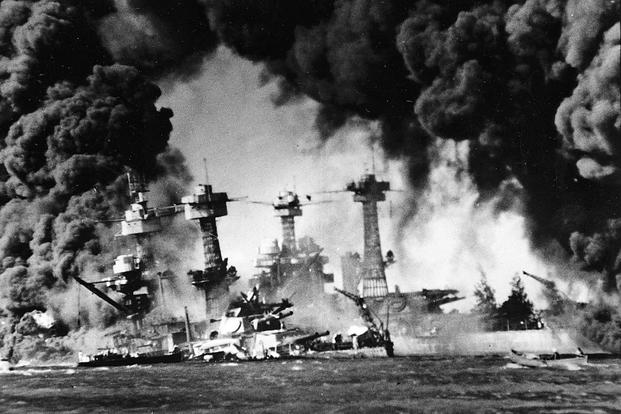Sundays were ice cream days for several of the destroyers in Pearl Harbor, and they were taking aboard gallons from a local dairy in the early morning hours just before the attack began Dec. 7, 1941.
The ship's log for the Mahan-class destroyer Conyngham, kept that morning by Lt. [j.g.] J.R. Hansen, noted: "Moored as before. 0630 [6:30 a.m.] Received the following provisions for use in general mess ... from Dairyman's Association Ltd: ice cream -- 6 gals."
Hansen attested to the quantity received, and Pharmacist's Mate P.C. Parcheski attested to its quality.
Hansen's next log entry noted that the nation was at war again.
"0755 Japanese planes commenced bombing Pearl Harbor Area. Held general quarters, manned all guns, commenced breaking out powder. Commenced emergency repairs on main engines to get underway. Captain on the bridge."
Another Mahan-class destroyer, the Cummings, was "moored as before" and received 15 gallons of milk and seven gallons of ice cream from Dairyman's Association Ltd. on that morning, according to the log kept by Lt. [j.g.] J.B. Carroll.
Carroll then noted: "0758 Air Raid. Japanese planes commenced torpedo attack on battleships in Pearl Harbor. Sounded General Quarters."
Carroll's next log entry gave a just-the-facts portrayal of the frantic attempts of the Cummings' sailors to repel the attack that would destroy much of the firepower of the Pacific Fleet.
"Moored as before. Manning battery at General Quarters. 0803 After machine guns opened fire on Japanese Torpedo Planes. 0808 Opened fire on horizontal bombers with main battery."
The next entries said: "0810 Commenced preparations for getting underway in accordance with signal flying on signal tower. 0811 Opened fire on dive bombers with main battery. 0820 Lull in air attack. Ceased fire."
"0840 Opened fire to repel strafing attack. 0842 Following machine gun fire from after machine guns, glide bomber was observed veer away from ship with smoke trailing from it."
The Wickes-class destroyer Chew, a veteran of World War I, also took on ice cream before going to general quarters and turning its deck guns on the swarming aircraft.
Ensign W.H. Hartz, made the following log entry: "0757 Suffered surprise air attack by Japanese torpedo and bombing planes. Sounded General Quarters and manned anti-aircraft battery. Light and heavy Japanese bombers crossed Pearl Harbor at high altitude scoring direct hits on various fleet units."
The Chew managed to get underway and began patrolling southwest of the port entrance for submarines. The ship dropped 28 depth charges, but there was no evidence any Japanese submarines were hit.
Some of the most harrowing log entries came from Ensign A.T. Nicholson Jr., aboard the Tennessee-class battleship California, flagship of the Pacific Fleet. The California was hit several times, and the crew was temporarily ordered to abandon ship as a drifting oil slick threatened to engulf her in flames.
"0820 ship was struck at frame 47 with torpedo," the California's log said. "0830 bomb struck topside abreast casemate #1, frame 59, penetrated main deck and exploded on second deck causing large fire. Ship listed 8° to port, commenced counter-flooding starboard voids."
"1002 Captain with approval of Commander Battle Force ordered the ship to be temporarily abandoned due to enveloping flames of fire of fuel oil on surface of water."
"1015 flames from fire on water having cleared ship, the order to abandon ship was cancelled and ship battle stations were remanned and fire on main deck starboard and casemates fought. Attack resumed by enemy aircraft."
The California was salvaged and returned to the fight in the Pacific. Forty-four sailors aboard the California were killed in a kamikaze attack in the Philippines in 1945.
The ships' logs and accounts from naval stations ashore were compiled from 1941-1978 and are now stored at the National Archives, which said they "provide some insight into the events of the day -- before, during, and after the attack -- through the eyes of those who witnessed it."
"The vast majority of these entries document routine functions carried out aboard a ship, yet those entered at Pearl Harbor on December 7, 1941, also capture elements of the shock and confusion brought by the Japanese attack," according to an Archives' preface to the logs.
In the confusion, the battleship Maryland, which was lightly damaged in the attack, logged a false report that Japanese paratroopers had descended from the skies over Pearl Harbor.
The ship's log had the following entry: "1137 Parachute troops reported landing on North Shore. 1143 Report received enemy troops wearing blue coveralls with red emblems."
It proved to be a minor distraction in the fog of battle.
"Before the day was over, 2,403 Americans were dead," the Archives report said. "In the two-hour attack, the U.S. Pacific Fleet was left nearly in ruins, with eight battleships, three cruisers, and 188 airplanes destroyed."
-- Richard Sisk can be reached at Richard.Sisk@Military.com.












